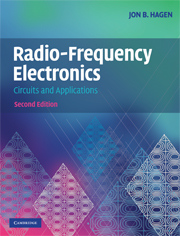Book contents
- Frontmatter
- Contents
- Preface
- 1 Introduction
- 2 Impedance matching
- 3 Linear power amplifiers
- 4 Basic filters
- 5 Frequency converters
- 6 Amplitude and frequency modulation
- 7 Radio receivers
- 8 Suppressed-carrier AM and quadrature AM (QAM)
- 9 Class-C, D, and E Power RF amplifiers
- 10 Transmission lines
- 11 Oscillators
- 12 Phase lock loops and synthesizers
- 13 Coupled-resonator bandpass filters
- 14 Transformers and baluns
- 15 Hybrid couplers
- 16 Waveguide circuits
- 17 Small-signal RF amplifiers
- 18 Demodulators and detectors
- 19 Television systems
- 20 Antennas and radio wave propagation
- 21 Radar
- 22 Digital modulation techniques
- 23 Modulation, noise, and information
- 24 Amplifier and oscillator noise analysis
- 25 The GPS Navigation system
- 26 Radio and radar astronomy
- 27 Radio spectrometry
- 28 S-parameter circuit analysis
- 29 Power supplies
- 30 RF test equipment
- Index
3 - Linear power amplifiers
Published online by Cambridge University Press: 05 June 2012
- Frontmatter
- Contents
- Preface
- 1 Introduction
- 2 Impedance matching
- 3 Linear power amplifiers
- 4 Basic filters
- 5 Frequency converters
- 6 Amplitude and frequency modulation
- 7 Radio receivers
- 8 Suppressed-carrier AM and quadrature AM (QAM)
- 9 Class-C, D, and E Power RF amplifiers
- 10 Transmission lines
- 11 Oscillators
- 12 Phase lock loops and synthesizers
- 13 Coupled-resonator bandpass filters
- 14 Transformers and baluns
- 15 Hybrid couplers
- 16 Waveguide circuits
- 17 Small-signal RF amplifiers
- 18 Demodulators and detectors
- 19 Television systems
- 20 Antennas and radio wave propagation
- 21 Radar
- 22 Digital modulation techniques
- 23 Modulation, noise, and information
- 24 Amplifier and oscillator noise analysis
- 25 The GPS Navigation system
- 26 Radio and radar astronomy
- 27 Radio spectrometry
- 28 S-parameter circuit analysis
- 29 Power supplies
- 30 RF test equipment
- Index
Summary
An amplifier is a circuit designed to impose a specified voltage waveform, V(t), or, sometimes, a specified current waveform, I(t), upon the terminals of a device known as the “load.” The specified waveform is often supplied in the form of an analog “input signal” such as the millivolt-level signal from a dynamic microphone. In a public address system, an audio amplifier produces a scaled-up copy of the microphone voltage (the input signal) and this amplified voltage (the output signal) is connected to a loudspeaker (the load). An audio amplifier generally supplies more than a watt to the loudspeaker. The microphone cannot supply more than milliwatts, so the audio amplifier is a power amplifier as well as a voltage amplifier. The ability to amplify power is really the defining characteristic of an amplifier. Of course energy must be conserved; amplifiers contain or are connected to power supplies, usually batteries or power line-driven ac-to-dc converter circuits, originally known as “battery eliminators” but long since simply called “power supplies” (see Chapter 29). The amplifiers discussed in this chapter are the basic “resistance-controlled” circuits in which transistors (or vacuum tubes) are used as electronically variable resistors to control the current through the load. Such circuits span the range from monolithic op-amps to the output amplifiers in high-power microwave transmitters.
Single-loop amplifier
Figure 3.1 shows the simplest resistance-controlled amplifier. This circuit is just a resistive voltage divider. The manually variable resistor (rheostat) in (a) represents the electronically variable resistor (transistor) in (b).
- Type
- Chapter
- Information
- Radio-Frequency ElectronicsCircuits and Applications, pp. 19 - 33Publisher: Cambridge University PressPrint publication year: 2009



